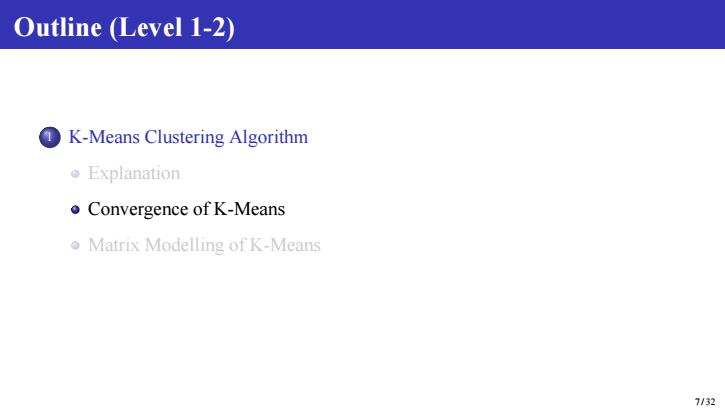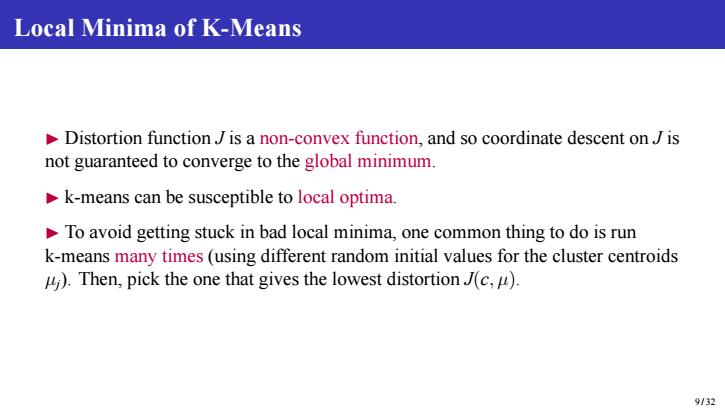
Statistical Learning Theory and Applications Lecture 10 Unsupervised Learning Instructor:Quan Wen SCSE@UESTC Fall 2021
Statistical Learning Theory and Applications Lecture 10 Unsupervised Learning Instructor: Quan Wen SCSE@UESTC Fall 2021

Outline (Level 1) DK-Means Clustering Algorithm ②PageRank 1/32
Outline (Level 1) 1 K-Means Clustering Algorithm 2 PageRank 1 / 32

Outline (Level 1) K-Means Clustering Algorithm PageRank 2/32
Outline (Level 1) 1 K-Means Clustering Algorithm 2 PageRank 2 / 32

1.K-Means Clustering Algorithm In the clustering problem,we are given a training set {x(),...x(,x()ER", and want to group the data into a few cohesive"clusters."No labels(are given. The k-means clustering algorithm is as follows: Initialize cluster centroidsE R",j=1,2,...,k,randomly. 2 Repeat until convergence: For each training samplex(),set c0=argmin|lr0-马l2 2 For every cluster centroid i,set ∑l(c0=r0 ∑1I(c0=) } I()is the indicator function. 3/32
1. K-Means Clustering Algorithm ▶ In the clustering problem, we are given a training set {x (1) , . . . , x (m)}, x (i) ∈ R n , and want to group the data into a few cohesive “clusters.” No labels y (i) are given. ▶ The k-means clustering algorithm is as follows: 1 Initialize cluster centroids µj ∈ R n , j = 1, 2, . . . , k, randomly. 2 Repeat until convergence: { 1 For each training sample x (i) , set c (i) = arg min j ∥x (i) − µj∥2 2 For every cluster centroid µj , set µj = Pm i=1 I(c (i) = j)x (i) Pm i=1 I(c (i) = j) } • I(·) is the indicator function. 3 / 32

Outline (Level 1-2) K-Means Clustering Algorithm 。Explanation Convergence of K-Means o Matrix Modelling of K-Means 4/32
Outline (Level 1-2) 1 K-Means Clustering Algorithm Explanation Convergence of K-Means Matrix Modelling of K-Means 4 / 32

1.1.Explanation k(hyper-parameter of the algorithm)is the number of clusters we want to find Cluster centroids urepresent our current guesses for the positions of the centers of the clusters. To initialize the cluster centroids we could choose k training sample randomly, and set the cluster centroids to be equal to the values of these k examples. The inner-loop of the algorithm repeatedly carries out two steps: .Assigning each training samplex(to the closest cluster centroid Moving each cluster centroid to the mean of the samples assigned to it. 5/32
1.1. Explanation ▶ k (hyper-parameter of the algorithm) is the number of clusters we want to find ▶ Cluster centroids µj represent our current guesses for the positions of the centers of the clusters. To initialize the cluster centroids we could choose k training sample randomly, and set the cluster centroids to be equal to the values of these k examples. ▶ The inner-loop of the algorithm repeatedly carries out two steps: • Assigning each training sample x (i) to the closest cluster centroid µj . • Moving each cluster centroid µj to the mean of the samples assigned to it. 5 / 32

(a) (b) (c) (d) (e) () Training samples (dots)and cluster centroids(crosses).(a)Original dataset.(b)Random initial cluster centroids (isn't equal to training samples).(c-f)Illustration of running two iterations of 2-means. 6/32
▶ Training samples (dots) and cluster centroids (crosses). (a) Original dataset. (b) Random initial cluster centroids (isn’t equal to training samples). (c-f) Illustration of running two iterations of 2-means. 6 / 32

Outline (Level 1-2) DK-Means Clustering Algorithm Explanation Convergence of K-Means o Matrix Modelling of K-Means 7/32
Outline (Level 1-2) 1 K-Means Clustering Algorithm Explanation Convergence of K-Means Matrix Modelling of K-Means 7 / 32

1.2.Convergence of K-Means Define the distortion function to be: m Jlc,)=∑lr0-4enl2 i=1 Jmeasures the sum of squared distances between each training samplex(and the cluster centroid u(o to which it has been assigned. k-means is exactly coordinate descent onJ. holding u fixed,minimizesJ w.r.t.c. 2 holding c fixed,minimizesJw.r.t.u. Jmust monotonically decrease,and the value ofJ must converge.Usually,this implies that c and u will converge too. 8/32
1.2. Convergence of K-Means ▶ Define the distortion function to be: J(c, µ) = Xm i=1 ∥x (i) − µc (i)∥2 ▶ J measures the sum of squared distances between each training sample x (i) and the cluster centroid µc (i) to which it has been assigned. ▶ k-means is exactly coordinate descent on J. 1 holding µ fixed, minimizes J w.r.t. c. 2 holding c fixed, minimizes J w.r.t. µ. ▶ J must monotonically decrease, and the value of J must converge. Usually, this implies that c and µ will converge too. 8 / 32

Local Minima of K-Means Distortion functionJ is a non-convex function,and so coordinate descent onJ is not guaranteed to converge to the global minimum. k-means can be susceptible to local optima. To avoid getting stuck in bad local minima,one common thing to do is run k-means many times(using different random initial values for the cluster centroids ui).Then,pick the one that gives the lowest distortion J(c,u). 9/32
Local Minima of K-Means ▶ Distortion function J is a non-convex function, and so coordinate descent on J is not guaranteed to converge to the global minimum. ▶ k-means can be susceptible to local optima. ▶ To avoid getting stuck in bad local minima, one common thing to do is run k-means many times (using different random initial values for the cluster centroids µj). Then, pick the one that gives the lowest distortion J(c, µ). 9 / 32